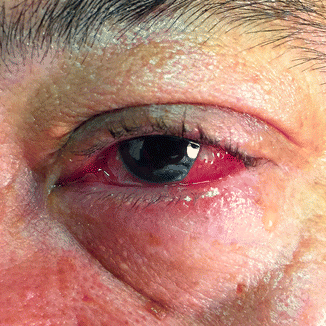Fig. 59.1
Maculopapular rash (Courtesy of Dr. Jorge Hidalgo, from Karl Heusner Memorial Hospital Belize)
Question
What diagnostic approach should be undertaken?
Answer
The presence of fever and arthralgias is a common clinical presentation in viral infections. In patients from tropical areas or with an appropriate travel history diseases sharing these symptoms include: Malaria, Rickettsiosis, Leptospirosis, Dengue, Chikungunya, and Group A Streptococcal infections. Early diagnosis of these conditions is based on a high index of clinical suspicion due to epidemiologic considerations (travel history, exposure, etc.) and the clinical presentation.
In this case, the history of recent traveling to the Caribbean and the abrupt onset fever with arthralgias and maculopapular rash serves to suggest certain diagnostic possibilities: Malaria, Chikungunya, Dengue and/or Leptospirosis. Thrombocytopenia and leucopenia are also suggestive of a viral process. The main laboratory finding in Chikungunya infection is lymphopenia, and is associated with viremia when the lymphocyte count is less than 1000 per cubic millimeter. Elevation of liver function tests are also reported, with SGOT and SGPT values elevated up to 1.5 times de normal level in up to 50 % of cases [1–8].
From the clinical point of view the presence of symmetrical arthritis, fever and a maculopapular rash in this patient are strongly suggestive of Chikungunya infection. An array of optic symptoms can develop, most commonly anterior uveitis, but conjunctivitis, even with injection similar to Leptospirois, may develop (Fig. 59.2) [9]. In patients with Dengue Fever the presence of arthritis is not as common, whereas hemorrhagic manifestations and shock are more frequent when compared to patients with Chikungunya. Table 59.1 compares the presentation of Chikungunya to that of Dengue.


Fig. 59.2
Conjunctivitis (Courtesy of Dr. Jorge Hidalgo, from Karl Heusner Memorial Hospital Belize)
Table 59.1
Clinical and laboratory features of Chikungunya virus infections compared with Dengue virus infections
Chikungunya | Dengue | |
|---|---|---|
Fever (>39°) | +++ | ++ |
Arthralgia | +++ | +/− |
Arthritis | + | – |
Headache | ++ | ++ |
Rash | ++ | + |
Myalgia | + | ++ |
Hemorrhage | +/− | ++ |
Shock | – | + |
Lymphopenia | +++ | ++ |
Neutropenia | + | +++ |
Thrombocytopenia | + | +++ |
Hemoconcentration | – | ++ |
The patient was initially managed with IV crystalloid administration in the emergency department. After a bolus of 20 cc/Kg her blood pressure returned to normal. Acetaminophen was used to control her temperature and arthralgias. Tests for serology were drawn. ELISA IgM for Chikungunya infection was reported as positive, ELISA IgM for Dengue and Leptospirosis were reported as negative. Tests for malaria were also reported negative. The patient, already stable, was admitted to the hospital and 4 days later was discharged home [1–3, 6].
Principles of Management
Diagnosis
Chikungunya infection is caused by a RNA virus that belongs to the Alphavirus genus in the family Togaviridae, that encodes four nonstructural proteins and three main structural proteins: the capsid and two envelope glycoproteins, E1 and E2 which forms spikes in the virion surface, E2 initiates cell entry through endocytosis and E1 initiates the release of nucleocapsids into the host cell system [2].

Full access? Get Clinical Tree







